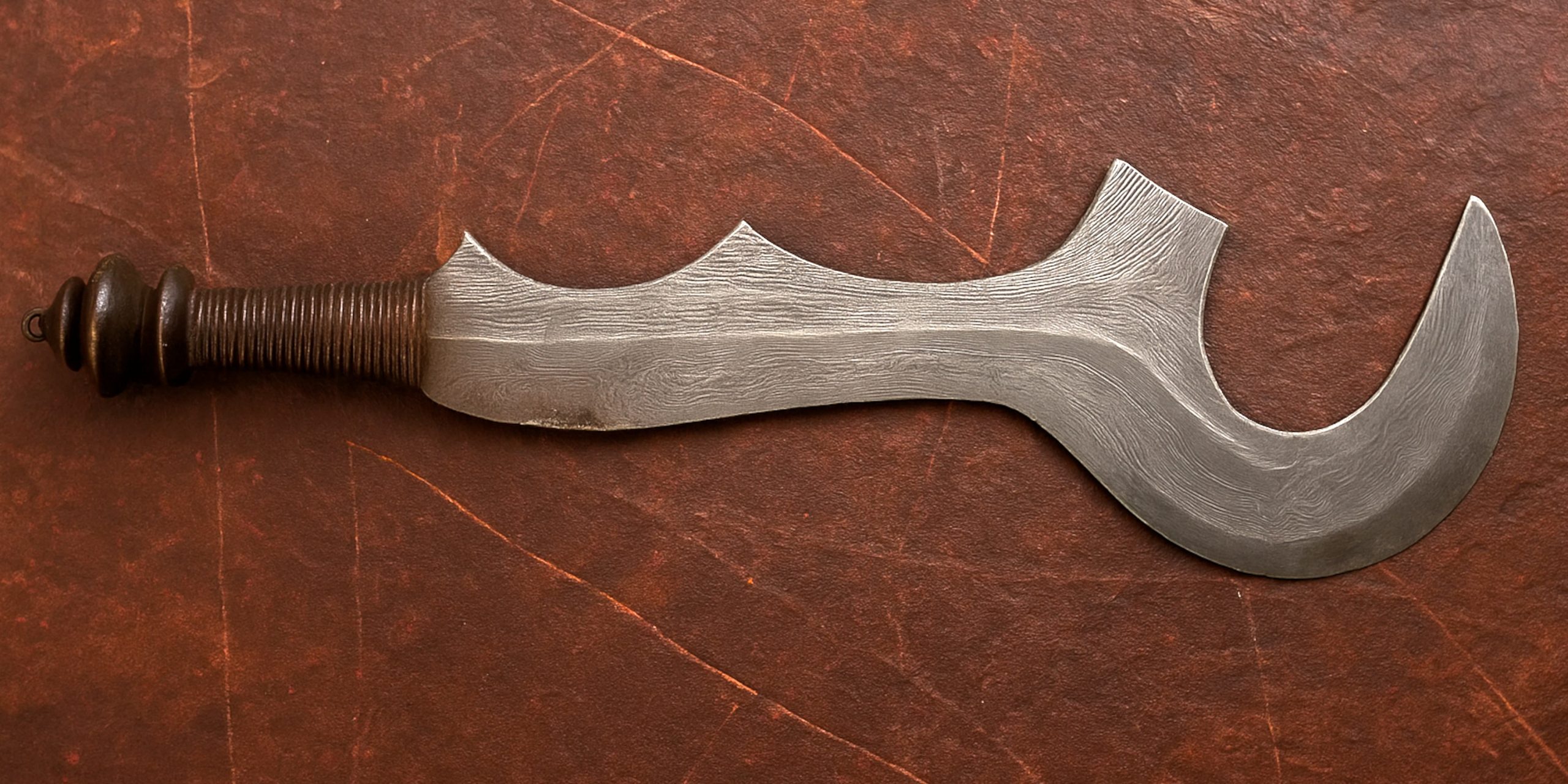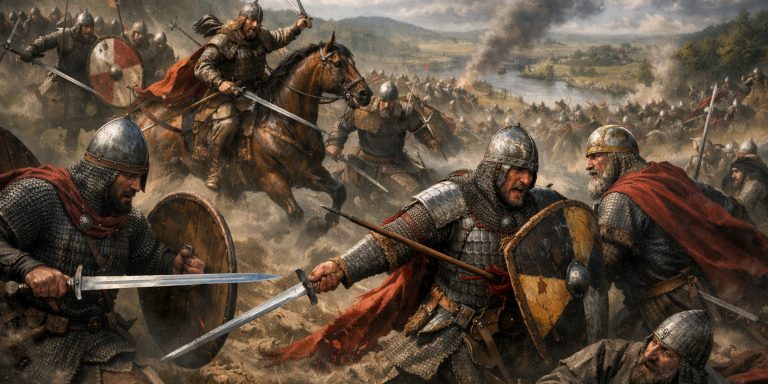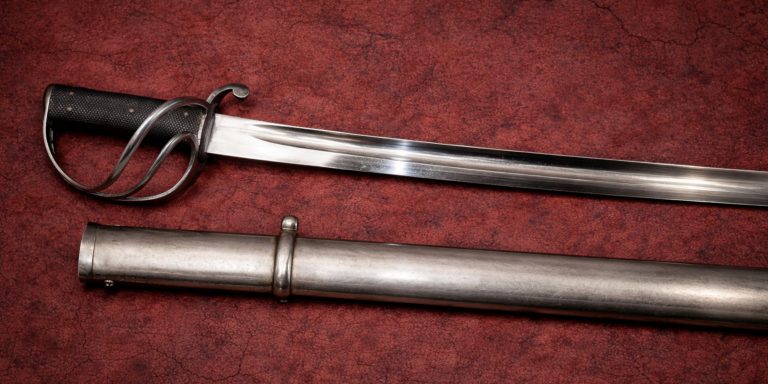
The Yaka sword is a distinctive traditional weapon from Central Africa, most commonly associated with the Yaka people of the Democratic Republic of the Congo. Known for its striking, almost abstract blade shape, the sword served as both a weapon and a symbol of authority. It sits at the crossroads between functional arms and ceremonial art, representing the fusion of craftsmanship and cultural identity in Central African metallurgy.
Although rarely used for combat in later centuries, the Yaka sword carried immense social significance, functioning as a mark of rank, a ritual implement, and even a bride-price item.
Specifications
| Feature | Description |
|---|---|
| Type | Short sword or ceremonial knife |
| Origin | Yaka people, Democratic Republic of the Congo |
| Date range | 18th to early 20th century |
| Overall length | 40–60 cm (varies by region and maker) |
| Blade material | Iron or steel, often hand-forged |
| Blade shape | Broad, asymmetrical, and often flared with hooked or lobed edges |
| Handle | Wood, wrapped in copper or brass wire; some feature leather bindings |
| Pommel | May include metal studs, anthropomorphic carving, or geometric forms |
| Weight | Approximately 500–800 grams |
| Primary function | Ceremonial, symbolic, or judicial rather than military |
History and Evolution
The Yaka sword developed from early regional blade traditions of Central Africa, where metallurgy was both a technical and spiritual discipline. The Yaka people, located near the Kwango River, were renowned for ironworking and ritual craft.
- Precolonial use: Early Yaka blades were designed for combat but quickly evolved into ceremonial objects. Chiefs and warriors used them as insignia of power.
- Ritual transformation: As trade and intertribal diplomacy expanded in the 18th and 19th centuries, the sword’s symbolic value grew. Its intricate form became a statement of status rather than a tool of war.
- Colonial period: Under Belgian colonial rule, Yaka swords became popular as collector’s items, with examples entering European museums and private collections.
- Modern legacy: While traditional forging declined in the 20th century, the sword remains a key artefact in ethnographic collections and Central African art markets.
Advantages and Disadvantages
Advantages
- Strong visual and cultural identity, reflecting Yaka artistic style.
- Balanced craftsmanship despite irregular shapes.
- Served as a multifunctional item: weapon, currency, and prestige object.
- Resistant to corrosion due to high iron purity in traditional smelting.
Disadvantages
- Limited combat efficiency due to decorative blade profile.
- Often heavy and awkward for sustained use in battle.
- Modern reproductions can obscure authenticity in the collector’s market.
Comparison with Similar Weapons
| Feature | Yaka Sword | Ngombe Execution Sword (Ngulu) | Kuba Ikakalaka | Mangbetu Trumbash |
|---|---|---|---|---|
| Region | Congo (Yaka) | Congo (Ngombe) | Congo (Kuba) | Northeastern Congo (Mangbetu) |
| Blade shape | Asymmetrical, flared, hooked | Broad, forward-curved | Crescent-shaped | Double-curved with a central ridge |
| Purpose | Ceremonial, symbolic | Execution, ritual | Prestige and judicial use | Prestige and combat |
| Decoration | Copper wrapping, carved pommel | Minimal | Geometric | Elaborate carving |
| Cultural use | Rank and authority | Judicial execution | Royal insignia | Symbol of noble rank |
The Yaka sword shares a regional lineage with these weapons, each combining metallurgical skill with artistic symbolism. However, the Yaka form remains among the most visually abstract and expressive.
Legacy
The Yaka sword is now considered an icon of Central African design. Its unusual form has influenced modern sculpture and design, appearing in ethnographic exhibits and art collections worldwide. For the Yaka people, the sword remains a link to ancestral identity and ceremonial heritage.
European collectors during the late 19th and early 20th centuries often compared it to “tribal sceptres”, while African historians have reframed it as a manifestation of spiritual authority rather than violence.
Where to See
| Location | Collection / Museum | Notes |
|---|---|---|
| Royal Museum for Central Africa, Tervuren, Belgium | Extensive collection of Yaka weaponry and regalia | Colonial-era acquisitions |
| Musée du Quai Branly, Paris, France | Features ritual and ceremonial blades from Central Africa | Includes several Yaka examples |
| The British Museum, London, UK | Holds 19th-century Yaka swords | Displayed in the Africa section |
| Metropolitan Museum of Art, New York | African arms and prestige objects | Occasionally displayed in rotating exhibits |
| National Museum of Kinshasa, DRC | Cultural heritage display | Locally forged examples |
Collectors Guide and Auction Prices
Collecting Considerations
- Authenticity: Genuine Yaka swords show hand-forged irregularities, patinated copper wire, and aged wood handles.
- Condition: Blade corrosion, handle looseness, and wire degradation affect value.
- Provenance: Museum-exhibited or well-documented examples command higher prices.
- Era: Precolonial and early colonial specimens are more valuable than late 20th-century reproductions.
Typical Market Values (2020–2025 trends)
| Condition | Provenance | Estimated Auction Price (GBP) |
|---|---|---|
| Museum-quality, 19th century | Verified ethnographic provenance | £3,000–£7,000 |
| Good condition, early 20th century | Known collector or field source | £1,200–£2,500 |
| Minor restoration | Private collection | £600–£1,000 |
| Modern reproduction | Tourist or decorative | £100–£300 |
Recent Auctions
- Bonhams Tribal Art Sale (2022) – Yaka prestige sword, copper-wrapped handle, sold for £3,800.
- Christie’s Paris (2023) – Yaka ceremonial blade with carved pommel, achieved £4,200.
- Sotheby’s Online African Art (2024) – Late 19th-century example with minimal corrosion, £6,100.
The Seven Swords Takeaway
The Yaka sword stands as a masterpiece of African metalwork, merging form and function into a singular cultural expression. Though its role as a weapon diminished over time, its symbolic importance only grew. Today, it represents both the artistry and authority of a people whose blades spoke not of conquest, but of identity and tradition.



